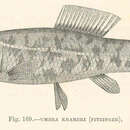Diagnostic Description
provided by Fishbase
Differs from Umbra pygmaea by the lack of dark blotch at caudal base, its body and head irregularly strewn with small dark sport, and having 33-35 scales in midlateral series (Ref. 59043).
Life Cycle
provided by Fishbase
Female guards the brood (Ref. 26183).
Trophic Strategy
provided by Fishbase
Inhabits small irrigation canals and slowly flowing and stagnant waters with dense vegetation (Ref. 26183). Territorial in shallow pools and swamps. Feeds on larger crustacean plankton and invertebrate larvae. This species is under threat due to habitat destruction, irrigation works and disappearance of shallow ditches as suitable habitats, restrictions of river inundation, pressure from introduced fish species and chemical pollution (Ref. 26183).
- Recorder
- Drina Sta. Iglesia
Biology
provided by Fishbase
Adults inhabit small irrigation canals and slowly flowing and stagnant waters with dense vegetation (Ref. 26183), usually in small ditches, oxbows, backwaters and shallow lakes (Ref. 59043). Territorial in shallow pools and swamps. They feed on larger crustacean plankton and invertebrate larvae (Ref. 26183). This species is under threat due to habitat destruction, irrigation works and disappearance of shallow ditches as suitable habitats, restrictions of river inundation, pressure from introduced fish species and chemical pollution (Ref. 26183).
Importance
provided by Fishbase
fisheries: of no interest; aquarium: commercial

